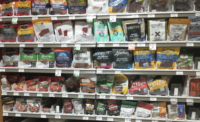When it comes to finding beef value at retail, consumers apparently are getting the message. More than half of shoppers (52%) identify the USDA Prime-grade on beef packaging as the leading indicator for value.
“No. 1 is Prime,” said Danette Amstein, principal at Midan Marketing. “Thank goodness No. 1 is Prime. We want USDA Prime to be what they see as the highest quality. The second one is Choice — that's 47%.”
Amstein detailed current market research findings and consumer trends during the recent Angus Convention in Salt Lake City.
Contraction in foodservice demand during the COVID-19-related restrictions and resulting restaurant shutdowns brought more USDA Prime meat into grocery stores. While shoppers are identifying USDA Prime-grade beef as an appealing value proposition, that is tempered with consumers dealing with food price inflation.
“What we are seeing is consumers are really asking for two things when they are buying meat right now,” Amstein said. “They want stability, and they want value. The stability side is really about trust, and some of that comes in the areas of brands and understanding brands and understanding that if I'm going to spend the money on this, I'm going to get what I expect to get.”
Price-conscious consumers are finding value in the meat case in a different way, Amstein said.
“To be of value, what entices me looks drastically different in this inflationary time. It really does match what we saw in the recession of 2008,” she said, adding that price-conscious shoppers are buying less expensive cuts, more grinds, larger pack sizes and freezing more.
“We're starting to see the total cost of beef come down a little bit,” she said. “We peaked in March. As it comes down a little bit, that's helping too.”
While price is paramount for many shoppers, for others finding value means time-saving convenience products.
“There is a segment of consumers from our meat segmentation research we call ‘convenience chasers,’ that even though they are price-conscious individuals, time is still their most valuable asset,” she said.
Getting the message
Research suggests point-of-sale retail messaging is critical to driving sales. On-pack QR codes can engage consumers by allowing them near-instant access to additional product information.
“The industry has done a good job of bringing that messaging to the meat case, Amstein said. “The latest National Meat Case Study says 94% of beef has some kind of a brand or some kind of information to Identify.”
With a lot of product messaging for beef shoppers to consider — free-range, pasture-raised, grass-fed — research suggests “free” messaging is one of the top claims consumers respond to:
- Four in 10 shoppers are looking for more no added hormones, no antibiotics and grass-fed options in the meat department.
- 34% of consumers specifically sought out claims-based meat (grass-fed, organic, antibiotic free, etc.) in 2021.
“You've got a group of consumers that for them, quality means a ‘never-ever’ product,” Amstein said. “You have a group of consumers that for them ‘natural’ means it is value-added. That is something we need to take into account. Grass-fed is a much smaller group of consumers who consider that a value add. It is more niche for a specific group of consumers.”
Consumers who buy grass-fed beef may not have higher-than-average incomes, but they are willing to spend a greater share of their income on food, she said.
Sustainability claims on beef product packaging is another message that connects with many consumers’ perceptions of the food they eat as a lifestyle brand.
“They are looking for the best way they can contribute to helping the environment in their minds,” Amstein said. “Whether that be social responsibility, whether that be sustainable packaging, whether that be companies that have very high, targeted sustainability goals in the next five to 10 years. They're really looking for ways that they can connect and contribute to those efforts.”
For those consumers, their No. 1 concern is how do they know the animal was taken care of, and producers need to share that story.
“Tell them,” Amstein said. “Share it. Get on social media. An Instagram post should be on your to-do list every week. Talk about what you're doing because you can give consumers themselves permission by which to enjoy your product.”

.png?height=96&t=1647275041&width=96)



Report Abusive Comment